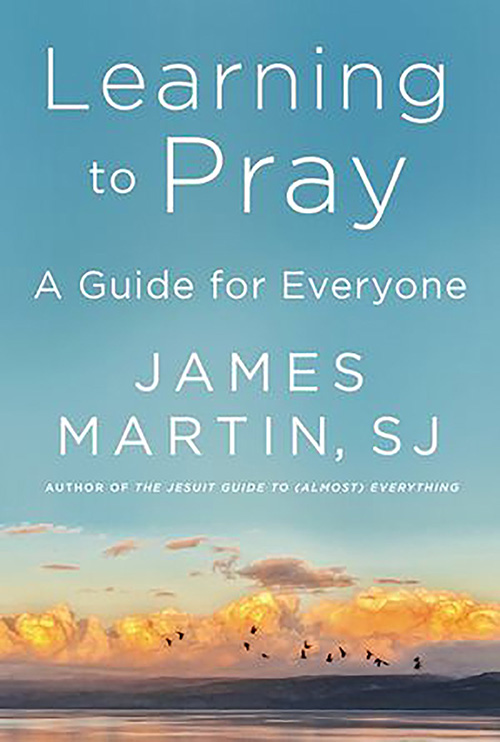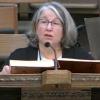
Jesuit Fr. James Martin, left, pictured in a 2019 photo, is the author of the new book "Learning to Pray: A Guide for Everyone." (Photos, clockwise: CNS/Gregory A. Shemitz; Unsplash/Jude Beck; Unsplash/Pedro Dias)

When I was younger, a nun told me that if I only prayed when I was in trouble, then I was indeed in trouble. That maxim was filed away and revived when I began reading Learning to Pray: A Guide for Everyone by Jesuit Fr. James Martin. For many people, prayer is a 911 call to God, used in moments of emergencies and tragedies. Without judgment, Martin offers a road map that shows how prayer is for everyone — including those who are unsure if they believe in God at all —at all sorts of times and manners.
Martin explains what prayer is and is not. Spoiler alert, the field of prayer is vast and not reserved for a select few. The practices described are often simple and open to all but never shallow. If I found one undercurrent running through Learning to Pray, it is not that prayer alone is accessible, but God is accessible to all. The book, written for a diversity of readers, especially cries out to those on the margins. The book invites those who have been away from church or those rejected into prayerful worship spaces. All are welcome.
Intentionally or not, when church or worship means online activity, this book comes as Martin has developed an ever larger online following. Despite being in its way evangelizing, the book offers a way into prayer, not religion, that is neither forceful, judgmental nor discriminating.
The book invites those who have been away from church or those rejected into prayerful worship spaces. All are welcome.
Learning to Pray is dedicated to Jesuit Fr. William Barry, the recently deceased spiritual director and author, who also figures prominently in the book. Barry had a profound influence on the spiritual lives of many and certainly in Martin's life as a Jesuit. His legacy runs like a river throughout the book, coursing through the numerous prayer and spiritual life options, offering life-giving water to support the invitation to worship.
Building from the introduction's "everyone can pray," Learning to Pray progresses chapter by chapter through various forms of prayer practices and experiences.
For many Christians, prayer means attending Mass or service and saying prescribed prayers such as the Our Father. While making clear that such things can be important in a life of faith, Martin writes that they are not the only way to pray. For me, this is where Learning to Pray seemed to shine the brightest, by encouraging everyone to open their hearts, minds and ears to God in a wide array of options.
One favorite chapter for me was the one on petitionary prayer. Martin aptly explores why this topic has a bad rap for some, and ways to approach asking for help. Remember, I learned that only praying when I was in trouble, was in and of itself trouble. A less mature version of me frequently felt too guilty to ask God for anything after a long silence on my part. What a relief that will be for many readers. We are reminded in this chapter that wanting to have God smite our enemies is not the best way to go, but that we can assuredly turn to God to pray for justice. The underlying direction is to become close enough to God to move beyond vengeance. After expressing our fury, praying for things like patience, wisdom or forgiveness can be nurtured through a relationship with the Divine.
Advertisement
Another revelatory gift among the many is the chapter about the Examen, a Jesuit prayer practice that, as its name suggests, is an examination of conscience typically prayed each night. Over time, people have adapted it to various circumstances. Still, the Examen is about recognizing God and seeing our behavior through a review of our day, along with a desire to improve tomorrow. In this chapter, Martin calls on his diverse priesthood and brings us deep into a troop of actors to set the stage for learning about this prayer. Talk about a way to make something that might be intimidating available to readers who might be unfamiliar with it or intimidated by it.
The many chapters in a book that might appear dauntingly large each offer many gifts and options of a life of prayer. Martin does an incredible job of clarifying that prayer is the medium of our relationship with God. Directing readers toward this relationship and encouraging a deepening of it is evident throughout. The author has a gift of writing with authority about topics grounded in solid theological and spiritual knowledge and then translating that into highly relatable and easy-to-read chapters. For all of its instructions, Learning to Pray is ultimately a conversation between Martin and the reader, pointing to the ultimate colloquy or prayer — communicating with God. This book deserves to be widely read by believers, skeptics and even unbelievers, if for no other reason than to broaden one's horizon. Just prepare to be changed, full-on believer or not, as you read.





